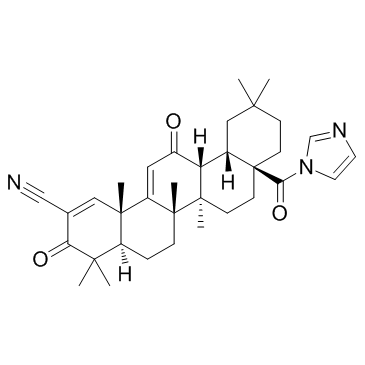CDDO-Im
Modify Date: 2025-08-23 07:34:14

CDDO-Im structure
|
Common Name | CDDO-Im | ||
|---|---|---|---|---|
| CAS Number | 443104-02-7 | Molecular Weight | 541.72400 | |
| Density | N/A | Boiling Point | N/A | |
| Molecular Formula | C34H43N3O3 | Melting Point | N/A | |
| MSDS | N/A | Flash Point | N/A | |
Use of CDDO-ImCDDO-Im (CDDO-imidazolide) is an activator of Nrf2 and PPAR, with Kis of 232 and 344 nM for PPARα and PPARγ. |
| Name | (4aR,6aR,6aS,6bR,8aS,12aS,14bS)-8a-(imidazole-1-carbonyl)-4,4,6a,6b,11,11,14b-heptamethyl-3,13-dioxo-4a,5,6,6a,7,8,9,10,12,12a-decahydropicene-2-carbonitrile |
|---|---|
| Synonym | More Synonyms |
| Description | CDDO-Im (CDDO-imidazolide) is an activator of Nrf2 and PPAR, with Kis of 232 and 344 nM for PPARα and PPARγ. |
|---|---|
| Related Catalog | |
| Target |
PPARα:232 nM (Ki) PPARγ:344 nM (Ki) Nrf2 |
| In Vitro | CDDO-Im is highly active in suppressing cellular proliferation of human leukemia and breast cancer cell lines (IC50 approximately 10-30 nM). In U937 leukemia cells, CDDO-Im also induces monocytic differentiation as measured by increased cell surface expression of CD11b and CD36[1]. Treatment with CDDO-Im elevates protein levels of Nrf2, a transcription factor previously shown to bind ARE sequences, and increases expression of a number of antioxidant and detoxification genes regulated by Nrf2[2]. CDDO-Im is one of the most potent synthetic triterpenoids shown to induce growth inhibition and apoptosis in various human cancer cells, including multiple myeloma, lung, pancreas and breast cancer. CDDO-Im treatment markedly induces cell cycle arrest at G2/M-phase and apoptosis in the triple-negative breast cancer cell lines, SUM159 and MDA-MB-231. The CD24−/EpCAM+ cells in SUM159 tumorspheres are significantly inhibited by CDDO-Im treatment. CDDO-Im also significantly decreases sphere forming efficiency and tumorsphere size in both primary and secondary sphere cultures[3]. |
| In Vivo | CDDO-Im is a potent inhibitor of de novo inducible nitric oxide synthase expression in primary mouse macrophages. Moreover, CDDO-Im inhibits growth of B16 murine melanoma and L1210 murine leukemia cells in vivo. Injection of 10 nM (5.4 μg) of CDDO-Im almost completely blocks the ability of IFN-γ to induce iNOS, and treatment with as little as 1 nmol of CDDO-Im (0.54 μg) is partially effective[1]. |
| Cell Assay | CDDO-Im is dissolved in DMSO. SUM159 and MDA-MB-231 cells are seeded into each well of 96-well plates (1,000 cell/well) and treated the next day with vehicle control or CDDO-Im (1, 10, 50, 100 and 200 nM) for given incubation time. The absorbance is measured with a spectrophotometer to determine cell proliferation rate[3]. |
| Animal Admin | Mice: Mice are injected i.p. with thioglycollate, and the resulting resident peritoneal macrophages are activated 3 days later with an i.p. injection of IFN-γ. CDDO and CDDO-Im are injected i.p. 30 min after IFN-γ. Macrophages are harvested 10 h later, cultured for 12 h, and then assayed for expression of iNOS protein and production of nitric oxide (NO)[1]. |
| References |
| Molecular Formula | C34H43N3O3 |
|---|---|
| Molecular Weight | 541.72400 |
| Exact Mass | 541.33000 |
| PSA | 92.82000 |
| LogP | 6.74288 |
| InChIKey | ITFBYYCNYVFPKD-FMIDTUQUSA-N |
| SMILES | CC1(C)CCC2(C(=O)n3ccnc3)CCC3(C)C(C(=O)C=C4C5(C)C=C(C#N)C(=O)C(C)(C)C5CCC43C)C2C1 |
| Storage condition | 2-8℃ |
| TP 235 |
| CDDO-Im |
| RTA 403 |
| CDDO Imidazolide |